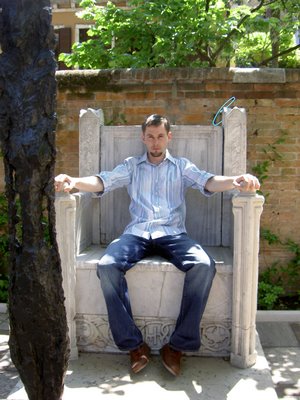
Saturday, March 29, 2008
summit

The summit of Montserrat is called Sant Jeroni (Saint Jerome) and stands at 1,236 meters (4,055 feet) above sea-level. It is accessible by hiking trails which connect from the top entrance to the Sant Joan funicular, the monastery, or the base of the mountain. From the summit, one can see in all directions (360 degrees) for many miles.
long way to the top if you wanna rock'n'roll


The mountain is composed of strikingly pink conglomerate, a form of sedimentary rock, popular with climbers.
montserrat

Montserrat is a mountain near Barcelona, in Catalonia, in Spain. It is the site of a Benedictine abbey, Santa María de Montserrat, which hosts the Virgin of Montserrat sanctuary and which is identified by some [1] with the location of the Holy Grail in Arthurian myth.
Wednesday, March 26, 2008
vista

The focal point of the park is the main terrace, surrounded by a long bench in the form of a sea serpent. To design the curvature of the bench surface Gaudí used the shape of buttocks left by a naked workman sitting in wet clay. The curves of the serpent bench form a number of enclaves, creating a more social atmosphere. Gaudí incorporated many motifs of Catalan nationalism, and elements from religious mysticism and ancient poetry, into the Park. The visitor was originally greeted by two life-size mechanical gazelles (a major euphemistic symbol of 'the young beloved' in the Hebrew strand of the medieval love poetry of the region), but these have since been lost during the turbulence of war.
columnas

Although it sounds unlikely, the place is skillfully designed and composed to bring the peace and calm that one would expect from a park. The buildings flanking the entrance, though very original and remarkable with fantastically shaped roofs with unusual pinnacles, fit in well with the use of the park as pleasure gardens and seem relatively inconspicuous in the landscape when one considers the flamboyance of other buildings designed by Gaudí.
Park Güell

The park was originally part of a commercially unsuccessful housing site, the idea of Count Eusebi Güell, whom the park was named after. It was inspired by the English garden city movement; hence the original English name Park. The site was a rocky hill with little vegetation and few trees, called Montaña Pelada (Bare Mountain). It already included a large country house called Larrard House or Muntaner de Dalt House, and was next to a neighborhood of upper class houses called La Salud. The intention was to exploit the fresh air (well away from smoky factories) and beautiful views from the site, with sixty triangular lots being provided for luxury houses. Count Eusebi Güell added to the prestige of the development by moving in 1906 to live in Larrard House. In the event only two houses were built, neither designed by Gaudi. One was intended to be a show house, but on being completed in 1904 was put up for sale, and as no buyers came forward. Gaudi, at Güell's suggestion, bought it with his savings and moved in with his family and his father in 1906.[1]
Mercat de la Boqueria (mariscos)

The first mention of the Boqueria market of Barcelona dates to 1217 when tables were installed near the old door of the city to sell meat. From December 1470, a market selling pigs occurred at this site. At this time, the Market had the name Mercat Bornet or was (until 1794) simply known as Mercat de la Palla (Straw Market). At the beginning, the market was not enclosed and did not have an official statute, it was regarded as a simple extension of the market of Plaça Nova which then extended to the Plaça del Pi.
Later, the authorities decided to construct a separate market on La Rambla, housing mainly fishmongers and butchers. It is not until 1826 that the market is legally recognized and a convention held in 1835 decides construction of an official place. Construction began March 19, 1840 under the direction of architect Mas Vilà. The market officially opened the same year, but the plans for the building were modified many times. The official inauguration of the structure was finally made in 1853. In 1911, the new fish market was opened and, in 1914, the metal roof that still exists today was constructed.
Casa Amatller


Casa Amatller is a building in the Modernisme style in Barcelona, designed by Josep Puig i Cadafalch. Along with Casa Batlló and Casa Lleó-Morera, it makes up the three most important buildings in Barcelona's famous Illa de la Discòrdia ("Block of Discord"), noted for its unique modernist buildings.
The building was originally designed as a residence for chocolatier Antoni Amatller and was constructed between 1898 and 1900.








































